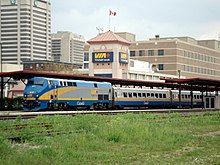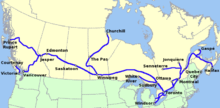VIA Rail Canada
| VIA Rail Canada
|
|
|---|---|
| legal form | Crown Corporation ( public company ) |
| founding | 1977 |
| Seat | Montréal |
| management | Cynthia Garneau (President and CEO ) |
| Number of employees | 3,115 (2018) |
| sales | $ 392.6 million (2018) |
| Branch | traffic |
| Website | www.viarail.ca |

VIA Rail Canada (also known as VIA Rail or VIA ) is Canada's state-owned railroad company for long-distance passenger transport, based in Montréal . VIA Rail has train services in eight provinces (excluding Newfoundland and Labrador and Prince Edward Island ) from the Atlantic to the Pacific and from the Great Lakes to Hudson Bay .
Since it was founded in 1977, VIA Rail has not been able to achieve economic independence and is dependent on permanent subsidy payments.
Traffic performance
VIA Rail operates approximately 454 train journeys per week and serves 121 stations across Canada. The train fleet currently comprises 430 passenger cars and 73 locomotives (as of 2019).
| year | Train kilometers in millions | Passengers in millions | Passenger kilometers in millions |
|---|---|---|---|
| 1999 | 10.4 | 3.57 | 1,424.3 |
| 2000 | 10.7 | 3.80 | 1,454.8 |
| 2001 | 10.7 | 3.87 | 1,482.2 |
| 2002 | 10.9 | 3.98 | 1,525.7 |
| 2003 | 10.9 | 3.79 | 1,379.2 |
| 2004 | 10.9 | 3.89 | 1,369.6 |
| 2005 | 10.8 | 4.10 | 1,429.1 |
| 2006 | 10.7 | 4.09 | 1,407.6 |
| 2007 | 10.7 | 4.18 | 1,407.6 |
| 2008 | 10.9 | 4.61 | 1,530.5 |
| 2009 | 10.7 | 4.23 | 1,379.2 |
| 2010 | 10.7 | 4.15 | 1,361.5 |
| 2011 | 10.6 | 4.13 | 1,369.6 |
| 2012 | 10.4 | 3.92 | 1,342.2 |
| 2013 | 10.0 | 3.89 | 1,338.9 |
| 2014 | 9.1 | 3.80 | 1,300.3 |
| 2015 | 10.2 | 3.80 | 1,322.8 |
| 2016 | 10.5 | 3.97 | 1,380.8 |
| 2017 | 10.8 | 4.39 | 1,535.3 |
| 2018 | 10.9 | 4.74 | 1,596.5 |
| 2019 | 11.1 | 5.00 | 1,679.8 |
The majority of the traffic volume is accounted for by intercity traffic in the Québec-Windsor corridor (96% of the passenger volume and 80% of the revenue; as of 2018).
Route network
VIA Rail operates around 12,500 kilometers and mainly uses the tracks of ten different railway companies. Only on 2% of the route, i.e. around 250 kilometers, do the trains run on track systems that belong to VIA itself. VIA Rail therefore only has a limited influence on punctuality, the consistent alignment of timetables to the demand for passenger transport services and the reduction of travel times.
Daily train service is only offered by VIA Rail in the Québec-Windsor Corridor .
Corridor trains
These trains operate daily InterCity connections between the larger cities in the corridor. They usually have economy and business class cars and stop at all or selected train stations on the route.
| route | Route length | Train frequency Monday to Friday |
Train frequency on Saturdays |
Train frequency on Sundays |
Remarks |
|---|---|---|---|---|---|
| Quebec - Montreal | 272 km | 5 | 3 | 3 | |
| Montreal - Ottawa | 187 km | 6-7 | 3-4 | 5 | |
| Montreal - Kingston - Toronto | 539 km | 5-6 | 4th | 5 | |
| Ottawa-Kingston-Toronto | 446 km | 7th | 4th | 5 | |
| Toronto - Kitchener - London - Sarnia | 290 km | 1-2 | 1-2 | 1-2 | |
| Toronto - Aldershot - London - Windsor | 359 km | 4-5 | 3-4 | 3-4 | |
| Toronto-Aldershot- Niagara Falls | 132 km | 1 | 1 | 1 | runs to / from New York City (see below) |
Tourist connections
These trains run as night trains on selected days of the week. They are geared more towards tourists than business travelers and are usually more expensive and slower than corresponding flight connections.
| route | Route length | Train frequency per week |
Remarks |
|---|---|---|---|
| Halifax - Montreal | 1,245 km | 3 | Night train, train name: The Ocean / L'Océan Matapédia –Montreal combined with the Gaspé – Montreal train |
| Gaspé - Montreal | 1,047 km | 3 | Night train Matapédia –Montreal merged with The Ocean Halifax – Montreal (bus replacement service since 2011 due to deficiencies in the superstructure and completely suspended since September 2013) |
| Toronto - Winnipeg - Edmonton - Jasper - Vancouver | 4,466 km | 2-3 | Night train, train name: The Canadian |
Regional connections
VIA Rail is obliged to operate these connections, as they otherwise only open up difficult-to-reach settlements. Usually only economy class cars are operated. As a special feature, some of these trains stop on the open route when necessary to pick up or drop off passengers or goods.
| route | Route length | Train frequency per week |
Remarks |
|---|---|---|---|
| Jonquière - Montreal | 510 km | 3 | Hervey –Montreal combined with train Senneterre – Montreal |
| Senneterre - Montreal | 717 km | 3 | Hervey – Montreal combined with the Jonquière – Montreal train |
| Winnipeg - The Pas - Churchill | 1,697 km | 3 | Night train, Winnipeg – Churchill twice a week, and The Pas – Churchill once a week |
| Jasper - Prince George - Prince Rupert | 1,160 km | 3 | the sections Jasper – Prince George and Prince George – Prince Rupert are served on two consecutive days, former train name until 2009: The Skeena |
| Sudbury - White River | 484 km | 3 | |
| The Pas - Pukatawagan | 251 km | 2 | Operated by Keewatin Railway Company |
| Victoria - Courtenay | 225 km | - | out of service due to route damage |
The cross-border train The Maple Leaf Toronto – Niagara Falls – New York City is operated jointly with the US railroad company Amtrak . The other cross-border train connections Adirondack Montreal – New York City (once a day) and Cascades Vancouver – Seattle (twice a day) are operated by Amtrak alone.
history
Analogous to the development in the USA , the two railway companies Canadian Pacific Railway (CP) and Canadian National Railway (CN) have been making losses with their passenger trains since the 1960s . In 1966, the National Transportation Act (NTA) decided to subsidize passenger trains. Despite a subsidy of up to 80 percent, passenger transport remained deficit. That is why it was decided in January 1976 that the state would cover 100 percent of the losses in future. Shortly afterwards, the Canadian National Railway presented its new offer under the VIA CN logo . The two companies CP and CN tried the following year to coordinate their offer. Since these efforts were relatively unsuccessful, the government founded the CN subsidiary VIA Rail Canada in 1977 , on whose supervisory board the CP should also be present. Since the cooperation did not improve, on March 31, 1978 VIA Rail Canada was converted into a Crown Corporation , whereby the company was directly under the government. As a result, VIA Rail bought the necessary passenger train equipment from CP and CN.
In the following years, numerous train connections were canceled, but new train equipment was also purchased. For example, between 1977 and 1981, VIA Rail procured the so-called LRC trains , which were supposed to offer more comfort than the TurboTrains' rolling stock previously used . By the end of the 1980s, enough state funds flowed so that the company could also enter the tourism business.
On February 8, 1986, when two trains collided near Hinton (Alberta) , the worst train accident in the history of VIA Rail occurred with 23 fatalities.
With an austerity course enacted in 1989, state subsidies were reduced by 50 percent, which led to the cancellation of more than half of the trains and a decline of over 45 percent in passenger numbers by 1990. In the following years, the number of passengers stabilized between 3.5 and 4.0 million and then increased slightly.
In 2000, an annual grant of 170 million Canadian dollars and a five-year investment plan of 400 million dollars were approved. This made it possible for VIA Rail to acquire modern P 42 series locomotives from General Electric as well as new wagons. These 139 cars were actually intended for the Eurotunnel traffic between Germany and Great Britain, but were never used for it. The VIA acquired the car in 2001 and prepared it for its own purposes under the type designation "Renaissance". The main areas of application are the night express The Ocean / L 'Océan and corridor trains previously driven with LRC material.
Since 1989, several studies on the establishment of high-speed rail traffic in the Quebec-Windsor corridor have been drawn up, implementation has so far failed due to funding.
In 2009 the previously used train names were given up and replaced by route names. Only The Canadian / Le Canadien and The Ocean / L'Océan kept their traditional names.
On February 25, 2012, a passenger train from Niagara Falls to Toronto crashed in Burlington (Ontario) . Three people were killed and 45 others were injured.
In September 2013, six bus passengers were killed in a Via Rail train collision with an OC Transpo bus in Ottawa near Fallowfield train station , while no one on the train was injured despite the derailment .
Funds will be provided in the 2018 budget so that Via Rail can renew the train material on the corridor connections. 32 diesel-powered train units suitable for push-pull operation are to be procured. Later additional equipment for electrical operation should be possible. Commissioning is scheduled for 2022. The contract was awarded to Siemens in December 2018. The train units will be equipped with Siemens Charger locomotives .
literature
- Tom Allen: Rolling Home. A Cross-Canada Railroad Memoir. Penguin, Toronto 2001, ISBN 0-670-88473-1 .
Web links
- VIA Rail website (English / French)
- VIA Rail website for Germany
Individual evidence
- ^ A b c Jean Dupuis, VIA Rail Canada and the Future of Passenger Rail in Canada. Publication 2011-93-E. Library of Parliament - Bibliothèque du Parlement, Ottawa, Ontario, November 16, 2011, accessed May 21, 2019 .
- ↑ a b Annual Report 2018. (PDF) VIA Rail, accessed on May 13, 2019 (English).
- ↑ VIA Rail: Annual Reports 2003–2019 accessed on July 1, 2012 (2003–2011), February 15, 2014 (2012), November 13, 2014 (2013), June 20, 2015 (2014), January 21, 2017 ( 2015), August 6, 2017 (2016), May 15, 2018 (2017), May 13, 2019 (English), July 16, 2020 (English)
- ↑ Our Business At A Glance. (PDF; 375 kB) VIA Rail, March 29, 2017, accessed on August 6, 2017 (English).
- ^ VIA Rail service between Matapédia, New Carlisle and Gaspé suspended. In: press release. Via Rail, August 22, 2013, accessed on August 28, 2018 .
- ↑ Passenger train derailed in Canada - dead and injured in train accident. In: RP Online. February 27, 2012. Retrieved July 18, 2012 .
- ↑ Ottawa bus-train crash kills 6 in commuting horror. In: cbc.ca. Retrieved November 12, 2014 .
- ^ The Fleet Renewal Program. VIA Rail, accessed on May 21, 2019 .
- ^ VIA RAIL selects Siemens Canada to replace its Québec-Windsor Corridor fleet. In: press release. VIA Rail, December 12, 2018, accessed December 13, 2018 .
- ↑ Siemens Mobility awarded € 650 million contract from VIA Rail Canada. (pdf) In: Press release Ref. No PR2018120112MOEN. Siemens Mobility GmbH, December 21, 2018, accessed on December 13, 2018 .





